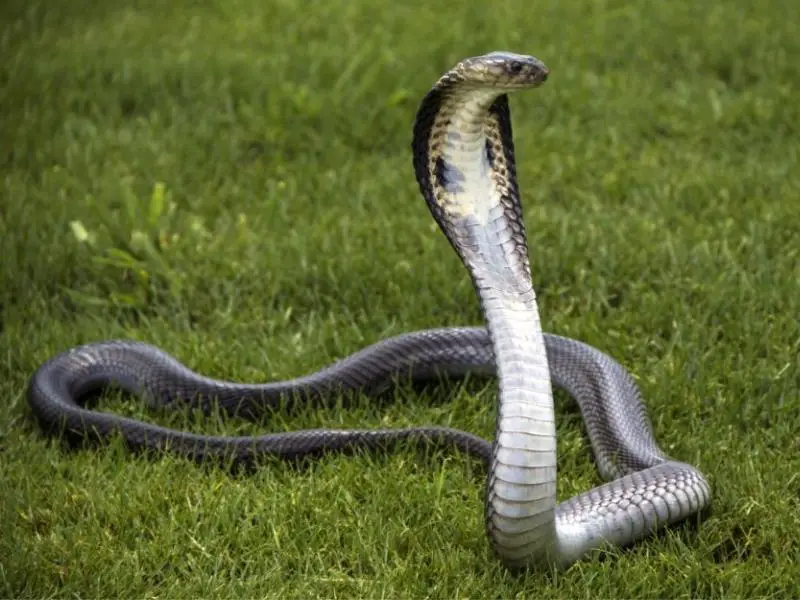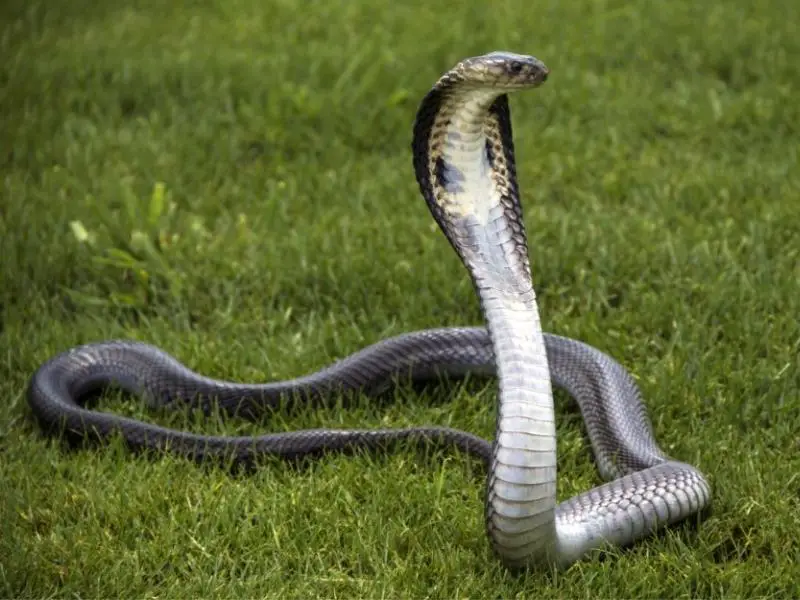Do you have a fascination with snakes? Are you curious about the different types of cobras found around the world? Look no further! This guide is specifically designed for snake enthusiasts who want to learn more about identifying different types of cobras.
From the iconic Indian Cobra to the deadly King Cobra, this guide covers the physical characteristics, habitats, and behaviors of various cobra species. Whether you’re a beginner or an experienced snake handler, this guide is the perfect resource for expanding your knowledge and understanding of these fascinating creatures. Let’s dive in!
Identifying Different Types of Cobras: a Guide for Snake Enthusiasts
If you’re a snake enthusiast, identifying different types of cobras can be a thrilling experience. Some of the most common types include the Indian cobra, King cobra, and the Cape cobra. To identify them, look for physical characteristics such as color, size, and markings. Use caution when handling cobras, as they are venomous and can be dangerous if not treated properly. Be sure to consult with a professional if you have any doubts.

Identifying Different Types of Cobras: a Guide for Snake Enthusiasts
Cobras are one of the most feared and fascinating snakes in the world. They are highly venomous and can be found in different parts of the world. Identifying different types of cobras is a crucial skill for snake enthusiasts, as it helps in understanding their behavior, habitat, and how to handle them safely. In this article, we will take a closer look at the different types of cobras and how to identify them.
1. Indian Cobra
The Indian cobra, also known as the spectacled cobra, is one of the most common and widespread species of cobras. It is found in India, Pakistan, Sri Lanka, and Bangladesh. The Indian cobra is easily recognized by the spectacle-like markings on its hood. The hood is used as a defensive display to scare off potential predators.
The Indian cobra is highly venomous and can deliver a fatal bite. Its venom affects the nervous system and can cause respiratory failure. However, the Indian cobra is not an aggressive snake and will only attack if it feels threatened. If you come across an Indian cobra, it is important to keep a safe distance and avoid provoking it.
2. King Cobra
The king cobra is the largest venomous snake in the world and is found in India, Southeast Asia, and the Philippines. It is easily recognized by its size and distinctive hood. Unlike other cobras, the king cobra feeds on other snakes, including other venomous species.
The venom of the king cobra is highly potent and can cause respiratory failure within minutes. It is important to treat a king cobra bite as a medical emergency. The king cobra is an aggressive snake and will attack if it feels threatened. If you come across a king cobra, it is important to keep a safe distance and seek professional help.
3. Black-necked spitting cobra
The black-necked spitting cobra is found in Sub-Saharan Africa and is easily recognized by its black hood and white markings on its neck. It is a highly venomous snake and can deliver venom through its fangs or by spitting it into the eyes of its prey or predator.
The venom of the black-necked spitting cobra can cause severe pain, swelling, and even blindness if it comes into contact with the eyes. It is important to wear protective eyewear if you are handling this snake. The black-necked spitting cobra is not an aggressive snake and will only attack if it feels threatened.
4. Egyptian cobra
The Egyptian cobra, also known as the Asp, is found in North Africa and the Middle East. It is easily recognized by its light brown or yellow hood and dark markings on its throat. The Egyptian cobra is a highly venomous snake and can deliver a fatal bite.
The venom of the Egyptian cobra affects the nervous system and can cause respiratory failure. It is important to seek professional help immediately if you are bitten by this snake. The Egyptian cobra is not an aggressive snake and will only attack if it feels threatened.
5. Forest cobra
The forest cobra is found in Central and West Africa and is easily recognized by its black or brown color and yellow markings on its throat. It is a highly venomous snake and can deliver a fatal bite.
The venom of the forest cobra affects the nervous system and can cause respiratory failure. It is important to seek professional help immediately if you are bitten by this snake. The forest cobra is not an aggressive snake and will only attack if it feels threatened.
6. Cape cobra
The Cape cobra is found in Southern Africa and is easily recognized by its light brown or yellow color and distinctive hood. It is a highly venomous snake and can deliver a fatal bite.
The venom of the Cape cobra affects the nervous system and can cause respiratory failure. It is important to seek professional help immediately if you are bitten by this snake. The Cape cobra is not an aggressive snake and will only attack if it feels threatened.
7. Philippine cobra
The Philippine cobra is found in the Philippines and is easily recognized by its light brown or yellow color and distinctive hood. It is a highly venomous snake and can deliver a fatal bite.
The venom of the Philippine cobra affects the nervous system and can cause respiratory failure. It is important to seek professional help immediately if you are bitten by this snake. The Philippine cobra is not an aggressive snake and will only attack if it feels threatened.
8. Monocled cobra
The monocled cobra is found in Southeast Asia and is easily recognized by the monocle-like marking on its hood. It is a highly venomous snake and can deliver a fatal bite.
The venom of the monocled cobra affects the nervous system and can cause respiratory failure. It is important to seek professional help immediately if you are bitten by this snake. The monocled cobra is not an aggressive snake and will only attack if it feels threatened.
9. Mozambique spitting cobra
The Mozambique spitting cobra is found in Sub-Saharan Africa and is easily recognized by its light brown or yellow color and distinctive hood. It is a highly venomous snake and can deliver venom through its fangs or by spitting it into the eyes of its prey or predator.
The venom of the Mozambique spitting cobra can cause severe pain, swelling, and even blindness if it comes into contact with the eyes. It is important to wear protective eyewear if you are handling this snake. The Mozambique spitting cobra is not an aggressive snake and will only attack if it feels threatened.
10. Coastal taipan
The coastal taipan, also known as the common taipan, is found in Australia and is easily recognized by its light brown or yellow color and distinctive hood. It is a highly venomous snake and can deliver a fatal bite.
The venom of the coastal taipan affects the nervous system and can cause respiratory failure. It is important to seek professional help immediately if you are bitten by this snake. The coastal taipan is not an aggressive snake and will only attack if it feels threatened.
In conclusion, identifying different types of cobras is an essential skill for snake enthusiasts. It helps in understanding their behavior, habitat, and how to handle them safely. Remember, if you come across a cobra, keep a safe distance and avoid provoking it. Seek professional help immediately if you are bitten by a highly venomous snake. Stay safe and happy exploring the world of snakes!
Frequently Asked Questions
Here are some common questions about identifying different types of cobras and their answers:
How many different types of cobras are there?
There are over 20 different types of cobras, each with their unique features, habitat, and behavior. Some of the most common types include the Indian cobra, king cobra, spitting cobra, and the Egyptian cobra.
Identifying different types of cobras requires keen observation and knowledge of their physical characteristics, such as their color, size, and shape of their hood or head. It’s also essential to understand their habitat and behavior, such as their hunting and defensive tactics.
What are the identifying features of a king cobra?
The king cobra is the largest venomous snake in the world and has some unique identifying features. They have a distinctive hood that spreads out when threatened, and their head is shaped like a teardrop. They have a brown or black color with white or yellow bands on their body.
King cobras also have a unique behavior of building nests for their eggs using leaves, twigs, and other materials. Identifying a king cobra requires knowledge of these physical and behavioral characteristics.
How do you differentiate between a spitting cobra and a non-spitting cobra?
Spitting cobras are known for their ability to spray venom at their prey or predators from a distance, while non-spitting cobras do not have this ability. Spitting cobras also have a more prominent and flattened hood compared to non-spitting cobras.
Identifying the type of cobra requires observation of its behavior, such as whether it spits venom or not, and its physical characteristics, such as the shape and size of its hood.
What are the identifying features of an Egyptian cobra?
Egyptian cobras are known for their distinctive coloring, which is a light sandy brown with black or dark brown spots. They also have a hood that is shaped like a spectacled eyeglass, with a dark line running across the top of its hood.
Identifying an Egyptian cobra also requires knowledge of their habitat, as they are commonly found in North Africa and the Middle East, and their behavior, such as their hunting habits and defensive tactics.
What should you do if you encounter a cobra?
If you encounter a cobra, it’s essential to remain calm and slowly move away from the snake. Do not try to approach or handle the snake, as it can be dangerous and potentially deadly. If you are bitten by a cobra, seek medical attention immediately as it can lead to severe health complications.
It’s also crucial to understand the local laws and regulations regarding snakes, as some species may be protected or prohibited from being handled or kept as pets.
In conclusion, identifying different types of cobras is a fascinating and important endeavor for snake enthusiasts. By understanding the unique characteristics and behaviors of each species, we can better appreciate and protect these magnificent creatures.
Whether you are a beginner or an experienced snake enthusiast, it is crucial to approach cobras with caution and respect. Always wear protective gear and seek the guidance of a knowledgeable expert before attempting to handle or interact with these dangerous snakes.
Finally, remember that the ultimate goal of identifying different types of cobras is not just to expand our knowledge, but also to promote conservation efforts. By working to protect these incredible creatures and their habitats, we can ensure that future generations will have the opportunity to appreciate and learn from these fascinating creatures.


